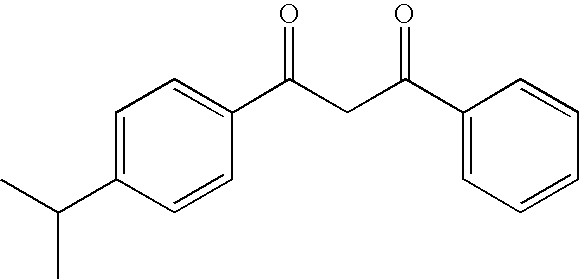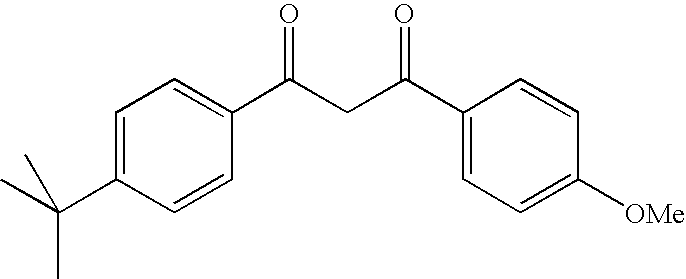Photoprotective cosmetic compositions comprising photostabilized dibenzoylmethane compounds and merocyanine sulfone compounds
a technology of dibenzoylmethane and merocyanine sulfone, which is applied in the direction of group 4/14 element organic compounds, cosmetic preparations, cosmetics, etc., can solve the problems of premature aging of the skin, inducing impairment, and browning of the skin, and achieve the effect of improving the stability of at least one dibenzoylmethane compound
- Summary
- Abstract
- Description
- Claims
- Application Information
AI Technical Summary
Benefits of technology
Problems solved by technology
Method used
Image
Examples
synthesis examples
Example 1
Preparation of Compound (k) with Formula (6)
[0172]
First step: Preparation of methyl 5-[allyl(methyl)amino]-2-[(4-methylphenyl)sulfonyl]penta-2,4-dienoate
[0173]3-Anilinoacrolein aniline (1.2 g, 5.4×10−3 mol) and methyl para-toluene sulfonyl acetate (1.48 g, 6.48×10−3 mol) was heated to 85-90° C. in 5 ml of acetic anhydride for 2 hours 30 minutes. The acetic anhydride was evaporated to dryness under reduced pressure. The oil obtained was taken up in 5 ml of ethanol. N-Methyl allylamine (1.115 ml, 0.0117 mol) was added and the mixture was heated under reflux for 4 hours 30 minutes. The ethanol was evaporated to dryness under reduced pressure. The orange-brown oil obtained was purified on a silica chromatographic column (eluent: EtOAc / heptane 20:80, then gradient to 30:70). 1.48 g of fractions (yield: 77%) of methyl 5-[allyl(methyl)amino]-2-[(4-methylphenyl)sulponyl]penta-2,4-dienoate were obtained in the form of a pale yellow oil:
UV (CH2Cl2):λmax = 370 nmE1% = 1346λmax = 356 n...
example 2
Preparation of Compound (f) with Formula (4)
[0176]
[0177]0.325 g (2 meq SiH) of methylhydro (50-55%) dimethylsiloxane (45-50%) copolymer (PS122.5 from Petrarch) was added dropwise over 10 minutes to a solution of methyl 5-[allyl(methyl)amino]-2-[(4-methylphenyl)sulfonyl]penta-2,4-dienoate (0.7 g, 2.1×10−3 mol) obtained in the first step of Example 1 and catalyst (complex containing 3-3.5% by weight of Pt in cyclovinylmethylsiloxane, from Hüls Petrarch PC085: 80 μl) in 2 ml of dry toluene heated to 80° C. It was left at this temperature for 6 hours. The reaction mixture was concentrated. It was taken up in dichloromethane and this solution was passed over a bed of Celite. The pale yellow oil obtained was chromatographed on a silica column (eluent: CH2Cl2). 0.92 g of fractions of the derivative of Example 2 was thus obtained in the form of a viscous pale yellow oil:
UV (Ethanol)
[0178]
λmax=371 nm E1%=728
example 3
Preparation of a Mixture of Compounds (m) with Formula (6)
[0179]
First step: Preparation of ethyl 5-[methyl(prop-2-ynyl)amino]-2-(phenylsulfonyl)penta-2,4-dienoate
[0180]3-Anilinoacrolein aniline (1.5 g, 6.75×10−3 mol) and ethyl phenylsulfonyl acetate (1.848 g, 8.1×10−3 mol) was heated to 85-90° C. in 5 ml of acetic anhydride for 3 hours. The acetic anhydride was evaporated to dryness under reduced pressure. The oil obtained was taken up in 5 ml of ethanol. N-Methyl propargylamine (1.22 ml, 0.0146 mol) was added and the mixture was heated under reflux for 5 hours. The ethanol was evaporated to dryness under reduced pressure. The orangish oil obtained was purified on a silica chromatographic column (eluent: EtOAc / heptane 50:50, then gradient to 30:70). 1.68 g of fractions (yield: 71%) of ethyl 5-[methyl(prop-2-ynyl)amino]-2-(phenylsulfonyl)penta-2,4-dienoate were obtained in the form of a pale yellow oil:
UV (CH2Cl2):λmax = 366 nmE1% = 1367λmax = 358 nm (shoulder)E1% = 1298
Second step: ...
PUM
| Property | Measurement | Unit |
|---|---|---|
| Fraction | aaaaa | aaaaa |
| Percent by mass | aaaaa | aaaaa |
| Fraction | aaaaa | aaaaa |
Abstract
Description
Claims
Application Information
 Login to View More
Login to View More - R&D
- Intellectual Property
- Life Sciences
- Materials
- Tech Scout
- Unparalleled Data Quality
- Higher Quality Content
- 60% Fewer Hallucinations
Browse by: Latest US Patents, China's latest patents, Technical Efficacy Thesaurus, Application Domain, Technology Topic, Popular Technical Reports.
© 2025 PatSnap. All rights reserved.Legal|Privacy policy|Modern Slavery Act Transparency Statement|Sitemap|About US| Contact US: help@patsnap.com



